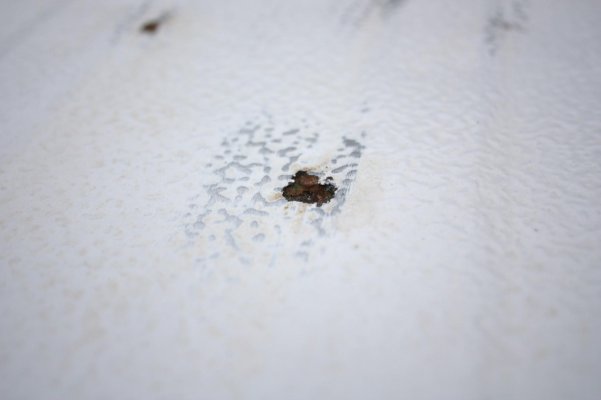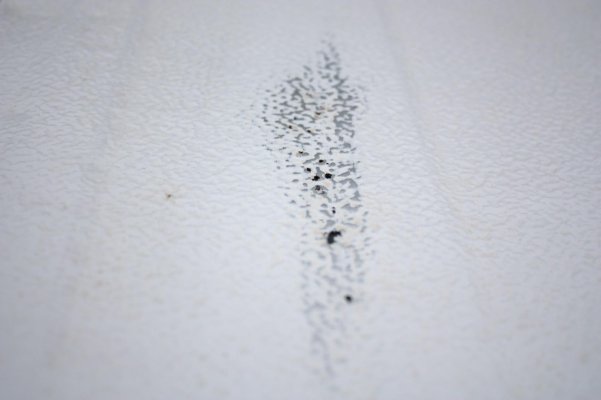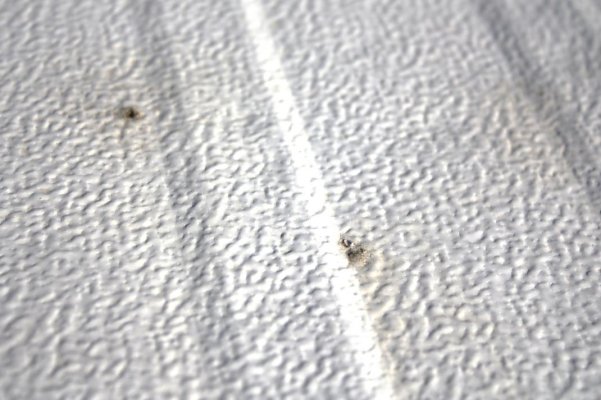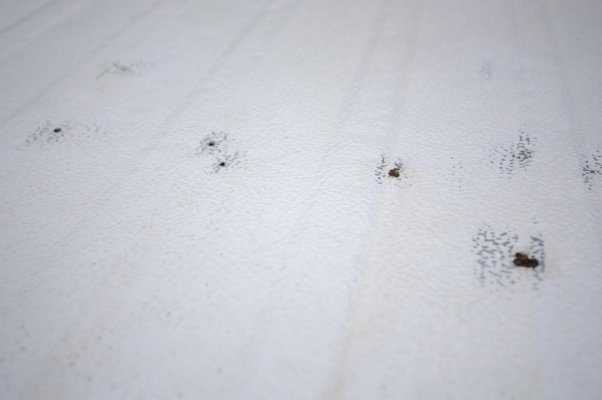jcurtis95
Senior Member
Crack in Shroud - Roof Repair
This will be my last post on this [until next spring]. I gave you some mis-information earlier. When I had the Hi Lo cleaned last month, the man remarked that it had a vinyl roof. When I initially found the damaged roof, I thought it was a metal roof and remarked the holes looked like they had been caused by an electrical burn. My initial thoughts turned out to be correct.
It was a cold day here in South Texas and I delayed repairing the roof until it had a chance to warm up, but it never got above 40 degrees. I don't like to apply Polyurethane or any other sealant material in this cooler temperature but I really had no choice as it is supposed to rain tonight and tomorrow. I warmed the sealant over the kitchen range before finally going out mid-afternoon.
I began by sanding the surfaces of the [39+] holes and discovered my initial observance was correct, it is not vinyl, rather it is aluminum with a vinyl coating. After cleaning each sanded area with a vinegar and water solution and letting it dry, I completed the initial repair. I do plan on using a rubber based roofing paint and cover the entire roof next spring as suggested by Bruce in yesterday's post.
I thought the forum should have an idea of what I found after sanding the area surrounding each hole so I have included additional photos. It is a mystery to me as to what happened on the roof. The affected area is in a direct line and extends approximately 10 feet on the driver's side down to just short of the AC unit. I am more certain than ever that the damage was caused by some sort of electrical contact seeking a path to ground. Each hole appears to have a burnt area surrounding the hole. The other sections of the roof show no damage whatsoever. Some of the holes are tiny while others are pretty large.
The BK polyurethane went on rather easily even in the cold but I had to stop and warm the tube so that it would come out easier. After I finished, Carol and I unfurled the RV Cover and put this baby to bed for the winter.
The interior dried out rather nicely with the heater blowing on it all night. Carol will get some contact paper to cover the affected cabinet area next spring. Hopefully, with the repairs and RV cover, we should have no further damage until we can continue repairs in the spring.
Our wishes go out to all members of this forum that you have a safe and very Merry Christmas.
Jerry & Carol Curtis
Fredericksburg, TX
2406 Towlite
This will be my last post on this [until next spring]. I gave you some mis-information earlier. When I had the Hi Lo cleaned last month, the man remarked that it had a vinyl roof. When I initially found the damaged roof, I thought it was a metal roof and remarked the holes looked like they had been caused by an electrical burn. My initial thoughts turned out to be correct.
It was a cold day here in South Texas and I delayed repairing the roof until it had a chance to warm up, but it never got above 40 degrees. I don't like to apply Polyurethane or any other sealant material in this cooler temperature but I really had no choice as it is supposed to rain tonight and tomorrow. I warmed the sealant over the kitchen range before finally going out mid-afternoon.
I began by sanding the surfaces of the [39+] holes and discovered my initial observance was correct, it is not vinyl, rather it is aluminum with a vinyl coating. After cleaning each sanded area with a vinegar and water solution and letting it dry, I completed the initial repair. I do plan on using a rubber based roofing paint and cover the entire roof next spring as suggested by Bruce in yesterday's post.
I thought the forum should have an idea of what I found after sanding the area surrounding each hole so I have included additional photos. It is a mystery to me as to what happened on the roof. The affected area is in a direct line and extends approximately 10 feet on the driver's side down to just short of the AC unit. I am more certain than ever that the damage was caused by some sort of electrical contact seeking a path to ground. Each hole appears to have a burnt area surrounding the hole. The other sections of the roof show no damage whatsoever. Some of the holes are tiny while others are pretty large.
The BK polyurethane went on rather easily even in the cold but I had to stop and warm the tube so that it would come out easier. After I finished, Carol and I unfurled the RV Cover and put this baby to bed for the winter.
The interior dried out rather nicely with the heater blowing on it all night. Carol will get some contact paper to cover the affected cabinet area next spring. Hopefully, with the repairs and RV cover, we should have no further damage until we can continue repairs in the spring.
Our wishes go out to all members of this forum that you have a safe and very Merry Christmas.
Jerry & Carol Curtis
Fredericksburg, TX
2406 Towlite






